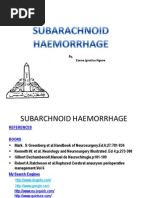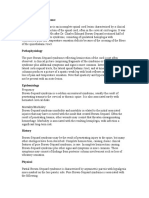Subdural Hematoma
Subdural Hematoma
Uploaded by
aaronmanullangCopyright:
Available Formats
Subdural Hematoma
Subdural Hematoma
Uploaded by
aaronmanullangCopyright
Available Formats
Share this document
Did you find this document useful?
Is this content inappropriate?
Copyright:
Available Formats
Subdural Hematoma
Subdural Hematoma
Uploaded by
aaronmanullangCopyright:
Available Formats
Subdural Hematoma
1 of 8
http://emedicine.medscape.com/article/1137207-overview
Medscape Reference
Reference
News
Reference
Education
MEDLINE
Subdural Hematoma
Author: Richard J Meagher, MD; Chief Editor: Helmi L Lutsep, MD more...
Updated: Mar 1, 2013
Background
A subdural hematoma (SDH) is a collection of blood below the inner layer of the dura but external to the brain and
arachnoid membrane (see the images below). Subdural hematoma is the most common type of traumatic intracranial
mass lesion.
Acute subdural hematoma. Note the bright (white) image properties of the blood on this noncontrast cranial CT scan. Note also the
midline shift. Image courtesy of J. Stephen Huff, MD
A left-sided acute subdural hematoma (SDH). Note the high signal density of acute blood and the (mild) midline shift of the ventricles.
Subdural hematoma occurs not only in patients with severe head injury but also in patients with less severe head
injuries, particularly those who are elderly or who are receiving anticoagulants. Subdural hematoma may also be
spontaneous or caused by a procedure, such as a lumbar puncture (see Etiology). Rates of mortality and morbidity
can be high, even with the best medical and neurosurgical care (see Prognosis).
Subdural hematomas are usually characterized on the basis of their size and location and the amount of time elapsed
since the inciting event age (ie, whether they are acute, subacute, or chronic). When the inciting event is unknown, the
appearance of the hematoma on neuroimaging studies can help determine when the hematoma occurred. These
factors, as well as the neurologic and medical condition of the patient, determine the course of treatment and may also
influence the outcome.
Generally, acute subdural hematomas are less than 72 hours old and are hyperdense compared with the brain on
computed tomography scans. The subacute phase begins 3-7 days after acute injury. Chronic subdural hematomas
develop over the course of weeks and are hypodense compared with the brain. However, subdural hematomas may
be mixed in nature, such as when acute bleeding has occurred into a chronic subdural hematoma.
Presentation varies widely in acute subdural hematoma (see Clinical). Many of these patients are comatose on
admission. However, approximately 50% of patients with head injuries who require emergency neurosurgery present
with head injuries that are classified as moderate or mild (Glasgow Coma Scale scores 9-13 and 14-15, respectively).
Many of these patients harbor intracranial mass lesions.
In a large series of patients who developed intracranial hematomas requiring emergent decompression, more than half
had lucid intervals and were able to make conversation between the time of their injury and subsequent deterioration.
26/06/2013 22:19
Subdural Hematoma
2 of 8
http://emedicine.medscape.com/article/1137207-overview
In a more comprehensive review of the literature on the surgical treatment of acute subdural hematomas, lucid
intervals were noted in up to 38% of cases.
These patients may be more likely to benefit from medical and surgical intervention when instituted in a timely fashion
(ie, before further neurological deterioration). See Treatment, as well as the Medscape Reference article Head Injury.
Acute subdural hematoma is commonly associated with extensive primary brain injury. In one study, 82% of comatose
patients with acute subdural hematomas had parenchymal contusions.[1] The severity of the diffuse parenchymal injury
shows a strong inverse correlation with the outcome of the patient.
In recognition of this fact, a subdural hematoma that is not associated with an underlying brain injury is sometimes
termed a simple or pure subdural hematoma. The term complicated has been applied to subdural hematomas in which
a significant injury of the underlying brain has also been identified.
Acute subdural hematoma is the most common type of traumatic intracranial hematoma, occurring in 24% of patients
who present comatose. This type of head injury also is strongly associated with delayed brain damage, later
demonstrated on CT scan. Such presentations portend devastating outcomes, and overall mortality rates are usually
quoted at around 60%.
Significant trauma is not the only cause of subdural hematoma. Chronic subdural hematoma can occur in the elderly
after apparently insignificant head trauma. Often, the antecedent event is never recognized. Chronic subdural
hematoma is a common treatable cause of dementia. A minority of chronic subdural hematoma cases derived from
acute subdural hematomas that have matured (ie, liquefied) because of lack of treatment.
For the most part, this review discusses acute and chronic subdural hematomas; less information is available about the
less common subacute subdural hematomas.[2] Atraumatic subdural hematoma and subdural hygroma are briefly
addressed.
Pathophysiology
The usual mechanism that produces an acute subdural hematoma is a high-speed impact to the skull. This causes
brain tissue to accelerate or decelerate relative to the fixed dural structures, tearing blood vessels.
Often, the torn blood vessel is a vein that connects the cortical surface of the brain to a dural sinus (termed a bridging
vein). In elderly persons, the bridging veins may already be stretched because of brain atrophy (shrinkage that occurs
with age).
Alternatively, a cortical vessel, either a vein or small artery, can be damaged by direct injury or laceration. An acute
subdural hematoma due to a ruptured cortical artery may be associated with only minor head injury, possibly without an
associated cerebral contusion. In one study, the ruptured cortical arteries were found to be located around the sylvian
fissure.[3]
The head trauma may also cause associated brain hematomas or contusions, subarachnoid hemorrhage, and diffuse
axonal injury. Secondary brain injuries may include edema, infarction, secondary hemorrhage, and brain herniation.
Typically, low-pressure venous bleeding from bridging veins dissects the arachnoid away from the dura, and the blood
layers out along the cerebral convexity. Cerebral injury results from direct pressure, increased intracranial pressure
(ICP), or associated intraparenchymal insults.
In the subacute phase, the clotted blood liquefies. Occasionally, the cellular elements layer can appear on CT imaging
as a hematocrit-like effect. In the chronic phase, cellular elements have disintegrated, and a collection of serous fluid
remains in the subdural space. In rare cases, calcification develops.
Much less common causes of subdural hematoma involve coagulopathies and ruptured intracranial aneurysms.
Subdural hematomas have even been reported to be caused by intracranial tumors.
It has been asserted that the primary brain injury associated with subdural hematoma plays a major role in mortality.
However, most subdural hematomas are thought to result from torn bridging veins, as judged by surgery or autopsy.
Furthermore, not all subdural hematomas are associated with diffuse parenchymal injury. As mentioned earlier, many
patients who sustain these lesions are able to speak before their condition deterioratesan unlikely scenario in
patients who sustain diffuse damage.
Using a primate model, Gennarelli and Thibault demonstrated that the rate of acceleration-deceleration of the head
was the major determinant of bridging vein failure. By using an apparatus that controlled head movement and
minimized impact or contact phenomena, they were able to produce acute subdural hematomas in rhesus monkeys. In
all cases, the sagittal movement of the head produced by an angular acceleration caused rupture of parasagittal
bridging veins and an overlying subdural hematoma.
Gennarelli and Thibault reported that their results were consistent with the clinical causes of subdural hematoma, in that
72% are associated with falls and assaults and only 24% are associated with vehicular trauma. The acceleration (or
deceleration) rates caused by falls and assaults are greater than those caused by the energy-absorbing mechanisms
in cars, such as dashboard padding, deformable steering wheels, and laminated windshields.[4]
Acute subdural hematoma
Investigation of brain physiological and biochemical parameters in patients with acute traumatic subdural hematoma
has suggested variables that might be associated with secondary injury to the brain.
In a study of brain biochemical patterns after acute subdural hematoma evacuation, Hlatky et al found that postsurgical
patients who succumbed to their injury exhibited lower values of brain tissue oxygen tension and higher dialysate
values of lactate and pyruvate in the brain underlying the hematoma. They suggested that identification of this brain
biochemistry pattern after surgery might signify an evolving brain injury that warrants further evaluation or treatment.[5]
Cerebral blood flow (CBF) can become markedly reduced. Schroder et al reported that in 2 patients with acute
subdural hematoma requiring emergent craniotomy, the hemisphere ipsilateral to the subdural hematoma
26/06/2013 22:19
Subdural Hematoma
3 of 8
http://emedicine.medscape.com/article/1137207-overview
demonstrated lower CBF than the contralateral hemisphere. Furthermore, CBF in both hemispheres was lower than
normal.[6]
Impressive increases in CBF and cerebral blood volume (CBV) that could not be attributed to pCO2 or blood pressure
changes were noted immediately after surgery. The authors speculated that the decreased CBV caused by the
subdural hematoma was a result of a compressed microcirculation, which was caused by increased ICP.[6]
Herniation
Like other masses that expand within the skull, subdural hematomas may become lethal by increasing pressure within
the brain, leading to pathologic shifts of brain tissue (brain herniations). Two common types of brain herniation are
subfalcial (cingulate gyrus) herniation and transtentorial (uncal) herniation.
Subfalcial herniation may cause a cerebral infarct via compression of the anterior cerebral artery, and transtentorial
herniation may cause an infarct via compression of the posterior cerebral artery. Transtentorial herniation is also
associated with pressure on the third cranial nerve, causing decreased reactivity and then dilation of the ipsilateral
pupil.
With progressive transtentorial herniation, pressure on the brainstem causes its downward migration. This tears critical
blood vessels that supply the brainstem, resulting in Duret hemorrhages and death. Increased ICP may also decrease
cerebral flood flow, possibly causing ischemia and edema; this further increases the ICP, causing a vicious circle of
pathophysiologic events.
Chronic subdural hematoma
Chronic subdural hematoma is commonly associated with cerebral atrophy. Cortical bridging veins are thought to be
under greater tension as the brain gradually shrinks from the skull; even minor trauma may cause one of these veins to
tear. Slow bleeding from the low-pressure venous system often enables large hematomas to form before clinical signs
appear.
Small subdural hematomas often spontaneously resorb. Larger collections of subdural blood usually organize and
form vascular membranes that encapsulate the subdural hematoma. Repeated bleeding from small, friable vessels
within these membranes may account for the expansion of some chronic subdural hematomas.
Chronic subdural hematomas may also evolve from the liquefaction of an acute subdural hematoma, particularly one
that is relatively asymptomatic. Liquefaction usually occurs after 1-3 weeks, with the hematoma appearing hypodense
on a CT scan.
Some chronic subdural hematomas may also enlarge from an osmotic gradient, drawing more fluid into the subdural
space, or through the separate mechanism of calcification.[7]
In 1989, Kawakami discovered that the coagulation and fibrinolysis systems were both excessively activated in chronic
subdural hematoma.[8] This results in defective clot formation and recurrent hemorrhage. Katano et al reported that
elevated concentrations of tissue plasminogen activator are found in some chronic subdural hematomas, and indicate
a relatively high probability of recurrence.[9]
As a subdural hematoma expands in the subdural space, it raises the ICP and deforms the brain. The rise in ICP is
initially compensated by efflux of cerebrospinal fluid (CSF) toward the spinal axis and compression of the venous
system, expediting venous drainage through the jugular veins. During this stage, ICP rises relatively slowly, because
the intracranial compliance is relatively high; in other words, the initial changes in intracranial volume are associated
with small changes in ICP.
However, as the hematoma (and edema from associated parenchymal injury) expands, a limit is reached beyond which
compensatory mechanisms fail. The intracranial compliance begins to decrease; small increases in intracranial volume
are associated with larger increases in ICP. The ICP rises exponentially, leading to decreased cerebral perfusion and
global cerebral ischemia. In a rapidly expanding hematoma, this whole process can happen in minutes.
In patients with chronic subdural hematoma, blood flow to the thalamus and basal ganglia regions appears to be
particularly affected compared to that to the rest of the brain. Tanaka et al suggested that impaired thalamic function
can lead to a spreading depression that impairs various cortical regions, thereby producing various clinical deficits.
They found that a 7% decrease of CBF was commonly associated with headache, whereas a 35% decrease of CBF
was associated with neurological deficit such as hemiparesis.[10]
Given that the pathophysiology of chronic subdural hematoma is often directly associated with cerebral atrophy, the
fact that subdural hematomas are associated with conditions that cause cerebral atrophy (eg, alcoholism, dementia) is
not surprising. In a series reported by Foelholm and Waltimo, alcoholics constituted over half of the patient population.
Most chronic subdural hematomas are probably caused by head injury; other causes and predisposing factors include
coagulopathy, use of anticoagulants (including aspirin), seizure disorders, and CSF shunts.[11]
Herniation syndromes
In addition to increasing the ICP, the hematoma deforms and displaces the brain. Eventually, transtentorial or
subfalcine herniation can develop as the brain is pushed past the dural folds of the tentorial incisura or falx,
respectively.
Tonsillar herniation through the foramen magnum may develop if the whole brain stem is forced down through the
tentorial incisura by elevated supratentorial pressure. Although much less common than supratentorial subdural
hematoma, infratentorial subdural hematoma can develop and cause tonsillar herniation and brainstem compression.
Characteristic herniation syndromes may develop as the brain shifts. As the medial temporal lobe, or uncus, herniates
past the tentorium, it can compress the ipsilateral posterior cerebral artery, oculomotor nerve, and cerebral peduncle.
Clinically, the consequent oculomotor nerve palsy and cerebral peduncle compression are often manifested by an
ipsilaterally dilated pupil and a contralateral hemiparesis.
The patient also may develop a stroke of the posterior cerebral artery distribution. In approximately 5% of cases, the
26/06/2013 22:19
Subdural Hematoma
4 of 8
http://emedicine.medscape.com/article/1137207-overview
hemiparesis may be ipsilateral to the dilated pupil. This phenomenon is called the Kernohan notch syndrome and
results when uncal herniation forces the midbrain to shift so that the contralateral cerebral peduncle is forced against
the contralateral tentorial incisura.
Subfalcine herniation caused by midline brain shift may result in compression of anterior cerebral artery branches
against the fixed falx cerebri, leading to infarcts in an anterior cerebral artery distribution.
Spontaneous subdural hematoma
Spontaneous subdural hematoma is rare. The literature is limited to sporadic case reports. These cases often have an
arterial source; they are usually associated with the same pathology as that involved in subarachnoid or intracerebral
hemorrhage. The blood from a ruptured aneurysm may dissect through the brain parenchyma or subarachnoid space
into the subdural space.
Likewise, the blood released from a "hypertensive" intracerebral hemorrhage can dissect into the subdural space. In
fact, a case has been reported of an acute spontaneous subdural hematoma precipitated by cocaine abuse.
Coagulopathy, occasionally associated with malignancy, also has been associated with spontaneous subdural
hematoma. Subdural hematoma also can be caused by bleeding from intracranial tumors. The treatment of
spontaneous subdural hematoma is similar to that of subdural hematoma caused by trauma, but the underlying cause
must be sought and treated.
Subdural hygroma
Some chronic subdural hematomas may be derived from subdural hygromas. Brain atrophy or loss of brain tissue due
to any cause, such as alcoholism, or stroke, may provide either an increased space between the dura and the brain
surface where a subdural hygroma can form (see the image below) or traction on bridging veins that span the gap
between the cortical surface and dura or venous sinuses.
Atrophy of the brain, resulting in a space between the brain surface and the skull, increases the risk of subdural hematoma (SDH).
Hygromas probably form after a tear in the arachnoid allows CSF to collect in the subdural space. A subdural hygroma
may therefore also occur after head trauma; they are frequently asymptomatic.
Etiology
Causes of acute subdural hematoma include the following:
Head trauma
Coagulopathy or medical anticoagulation (eg, warfarin [Coumadin], heparin, hemophilia, liver disease,
thrombocytopenia)
Nontraumatic intracranial hemorrhage due to cerebral aneurysm, arteriovenous malformation, or tumor
(meningioma or dural metastases)
Postsurgical (craniotomy, CSF shunting)
Intracranial hypotension (eg, after lumbar puncture, lumbar CSF leak, lumboperitoneal shunt, spinal epidural
anesthesia[12]
Child abuse or shaken baby syndrome (in the pediatric age group)
Spontaneous or unknown (rare)
Causes of chronic subdural hematoma include the following:
Head trauma (may be relatively mild, eg, in older individuals with cerebral atrophy)
Acute subdural hematoma, with or without surgical intervention
Spontaneous or idiopathic
Risk factors for chronic subdural hematoma include the following:
Chronic alcoholism
Epilepsy
Coagulopathy
Arachnoid cysts
Anticoagulant therapy (including aspirin)
Cardiovascular disease (eg, hypertension, arteriosclerosis)
Thrombocytopenia
Diabetes mellitus
In younger patients, alcoholism, thrombocytopenia, coagulation disorders, and oral anticoagulant therapy have been
found to be more prevalent. Arachnoid cysts are more commonly associated with chronic subdural hematoma in
patients younger than 40 years.
In older patients, cardiovascular disease and arterial hypertension are found to be more prevalent. In one study, 16%
of patients with chronic subdural hematomas were on aspirin therapy. Major dehydration is a less commonly
26/06/2013 22:19
Subdural Hematoma
5 of 8
http://emedicine.medscape.com/article/1137207-overview
associated condition and is found concurrently in only 2% of patients.
Epidemiology
Mortality/Morbidity
Acute subdural hematomas have been reported to occur in 5-25% of patients with severe head injuries, depending on
the study. The annual incidence of chronic subdural hematoma has been reported to be 1-5.3 cases per 100,000
population. More recent studies have shown a higher incidence, probably because of better imaging techniques.
Sex- and age-related differences in incidence
Overall, subdural hematomas are more common in men than in women, with a male-to-female ratio of approximately
3:1. Men also have a higher incidence of chronic subdural hematoma. The male-to-female ratio has been reported to
be 2:1.
The incidence of chronic subdural hematoma appears to be highest in the fifth through seventh decades of life. One
retrospective study reported that 56% of cases were in patients in their fifth and sixth decades; another study noted
that more than half of all cases were seen in patients older than 60 years. The highest incidence, 7.35 cases per
100,000 population, occurs in adults aged 70-79 years.
Adhesions existing in the subdural space are absent at birth and develop with aging; therefore, bilateral subdural
hematomas are more common in infants. Interhemispheric subdural hematomas are often associated with child
abuse.[13]
Prognosis
The mortality associated with acute subdural hematoma has been reported to range from 36-79%. Many survivors do
not regain previous levels of functioning, especially after an acute subdural hematoma severe enough to require
surgical drainage. Favorable outcome rates after acute subdural hematoma range from 14-40%.
Several series have shown an increase in favorable outcome in younger patients.[14] Age younger than 40 years was
associated with a mortality rate of 20%, whereas age 40-80 years was associated with a mortality rate of 65%. Age
older than 80 years carried a mortality rate of 88%.
Ultimate prognosis is related to the amount of associated direct brain damage and the damage resulting from the
mass effect of the hematoma. Simple acute subdural hematoma (ie, without parenchymal injury) accounts for about
half of all cases and is associated with a mortality rate of about 20%. Complicated subdural hematoma (eg, with
accompanying contusion or laceration of a cerebral hemisphere) is associated with a mortality rate of about 60%.
Findings on CT scan or MRI may help indicate prognosis. Such findings may include the following[15] :
Thickness or volume of the hematoma
Degree of midline shift
Presence of associated traumatic intraparenchymal lesions
Compression of the brainstem or basal cisterns
The first CT scan may underestimate the size of parenchymal contusions.
In general, a poor preoperative neurologic status may be a harbinger of a poor outcome. In addition to factors
discussed above, poor prognostic indicators for acute subdural hematoma have been reported to include the
following[16, 17, 15] :
Low initial (< 8) and postresuscitation (< 8) Glasgow coma scale
Low Glasgow coma scale motor score on admission (< 5)
Pupillary abnormalities
Alcohol use
Injury by motorcycle accident
Ischemic damage[18]
Hypoxia or hypotension
Difficulty in controlling ICP
Elevated ICP postoperatively indicates a poor prognosis and may indicate the severity of the underlying brain injury
(eg, trauma, secondary infarction).
In a retrospective review of 109 consecutive patients with head injury with a CT scan diagnosis of acute traumatic
subdural hematoma, Phuenpathom et al found that poor outcome was strongly correlated with the best sum GCS
score within the first 24 hours of head injury and pupillary inequality. Age and pupillary reaction to light also correlated
well with the outcome.
The mortality in the whole series was 50%, and mortality for all 37 patients with a GCS score of 3 was 100% (this rate
decreased as the GCS increased). The mortality for those with unequal pupils was 64%, versus 40% for those with
equal pupils. The mortality associated with one nonreactive pupil was 48%, versus 88% with bilateral nonreactive
pupils. The outcome status of the patients with bilateral nonreactive pupils who survived was not noted.[19]
Wilberger et al also found an 88% mortality associated with fixed, dilated pupils and noted a 7% functional recovery in
survivors with this finding. This study found that neurologic presentation and postoperative ICP (which was not
evaluated by Phenpatham et al) were strong predictors of outcome. Wilberger et al also found a trend of increasing
mortality rate with age, although it was not statistically significant.[16]
A review by Sakas et al of 1-year outcomes following craniotomy for traumatic hematomas in patients with fixed,
dilated pupils suggested that the presence of an acute subdural hematoma was the single most important predictor of
a negative outcome. Patients with subdural hematomas had a mortality of 64%, compared with a mortality of 18% in
26/06/2013 22:19
Subdural Hematoma
6 of 8
http://emedicine.medscape.com/article/1137207-overview
patients with extradural hematomas.[20]
Seelig et al also showed that neurologic examination findings and postoperative ICP were important prognostic
factors. The peak ICP was less than 20 mm Hg in 53% of patients with acute traumatic subdural hematoma (similar to
59% of patients with other types of head injuries), but this group accounted for 79% of the patients with functional
recoveries.
All patients with uncontrollably elevated ICP (>60 mm Hg) died. These authors claimed a 25% functional recovery rate
(defined by the Glasgow Outcome Scale) in patients presenting with fixed, dilated pupils.[21]
Acute subdural hematomas that would otherwise be considered operative by imaging criteria may resolve on their own,
although this is rare. A series of 4 such patients was reported by Kapsalaki et al.[22]
No clear prognostic factors are associated with chronic subdural hematoma. While some authors have found an
association with preoperative level of neurological function and outcome, others have not. Early diagnosis before
significant neurologic deterioration may correlate with a more favorable prognosis. No correlation has been found
between preoperative CT scan findings and postoperative outcome.
The mortality within 30 days of surgery is 3.2-6.5%. Eighty percent of patients resume their prehematoma level of
function. Sixty-one percent of patients aged 60 years or younger and in 76% of patients older than 60 years have
favorable outcomes. In a relatively recent series, 89.4% of patients with chronic SDH who were treated with a closed
drainage system had a good recovery and 2.2% worsened.[23]
Mori et al found that old age, pre-existing cerebral infarction, and subdural air after surgery correlated with poor brain
expansion.[24] Stanisic et al reported a 14.9% postoperative recurrence rate; various factors were associated with
this.[24]
The morbidity and mortality rates associated with surgical treatment of chronic subdural hematoma have been
estimated at 11% and 5%, respectively. Between 86% and 90% of patients with chronic subdural hematoma are
adequately treated after one surgical procedure.
Contributor Information and Disclosures
Author
Richard J Meagher, MD Attending Neurosurgeon, Neurosurgical Associates of Abington, Abington Memorial
Hospital
Richard J Meagher, MD is a member of the following medical societies: American Association of Neurological
Surgeons, Congress of Neurological Surgeons, and North American Spine Society
Disclosure: Nothing to disclose.
Coauthor(s)
William F Young, MD Attending Neurosurgeon, Fort Wayne Neurological Center
William F Young, MD is a member of the following medical societies: Congress of Neurological Surgeons
Disclosure: Nothing to disclose.
Chief Editor
Helmi L Lutsep, MD Professor and Vice Chair, Department of Neurology, Oregon Health and Science University
School of Medicine; Associate Director, Oregon Stroke Center
Helmi L Lutsep, MD is a member of the following medical societies: American Academy of Neurology and
American Stroke Association
Disclosure: Co-Axia Consulting fee Review panel membership; AGA Medical Consulting fee Review panel
membership; Stryker Neurovascular Consulting fee Review panel membership
Additional Contributors
Howard S Kirshner, MD Professor of Neurology, Psychiatry and Hearing and Speech Sciences, Vice Chairman,
Department of Neurology, Vanderbilt University School of Medicine; Director, Vanderbilt Stroke Center; Program
Director, Stroke Service, Vanderbilt Stallworth Rehabilitation Hospital; Consulting Staff, Department of Neurology,
Nashville Veterans Affairs Medical Center
Howard S Kirshner, MD is a member of the following medical societies: Alpha Omega Alpha, American Academy of
Neurology, American Heart Association, American Medical Association, American Neurological Association,
American Society of Neurorehabilitation, National Stroke Association, Phi Beta Kappa, and Tennessee Medical
Association
Disclosure: Nothing to disclose.
Norman C Reynolds Jr, MD Neurologist, Veterans Affairs Medical Center of Milwaukee; Clinical Professor,
Medical College of Wisconsin
Norman C Reynolds Jr, MD is a member of the following medical societies: American Academy of Neurology,
Association of Military Surgeons of the US, Movement Disorders Society, Sigma Xi, and Society for Neuroscience
Disclosure: Nothing to disclose.
Francisco Talavera, PharmD, PhD Adjunct Assistant Professor, University of Nebraska Medical Center College
of Pharmacy; Editor-in-Chief, Medscape Drug Reference
Disclosure: Medscape Salary Employment
26/06/2013 22:19
Subdural Hematoma
7 of 8
http://emedicine.medscape.com/article/1137207-overview
References
1. Kotwica Z, Brzezinski J. Acute subdural haematoma in adults: an analysis of outcome in comatose patients.
Acta Neurochir (Wien). 1993;121(3-4):95-9. [Medline].
2. Morinaga K, Matsumoto Y, Hayashi S, Omiya N, Mikami J, Sato H, et al. [Subacute subdural hematoma:
findings in CT, MRI and operations and review of onset mechanism]. No Shinkei Geka. Mar
1995;23(3):213-6. [Medline].
3. Matsuyama T, Shimomura T, Okumura Y, Sakaki T. Rapid resolution of symptomatic acute subdural
hematoma: case report. Surg Neurol. Aug 1997;48(2):193-6. [Medline].
4. Gennarelli TA, Thibault LE. Biomechanics of acute subdural hematoma. J Trauma. Aug 1982;22(8):680-6.
[Medline].
5. Hlatky R, Valadka AB, Goodman JC, Robertson CS. Evolution of brain tissue injury after evacuation of acute
traumatic subdural hematomas. Neurosurgery. Jul 2007;61(1 suppl):249-254. [Medline].
6. Schroder ML, Muizelaar JP, Kuta AJ. Documented reversal of global ischemia immediately after removal of
an acute subdural hematoma. Report of two cases. J Neurosurg. Feb 1994;80(2):324-7. [Medline].
7. Atkinson JL, Lane JI, Aksamit AJ. MRI depiction of chronic intradural (subdural) hematoma in evolution. J
Magn Reson Imaging. Apr 2003;17(4):484-6. [Medline].
8. Kawakami Y, Chikama M, Tamiya T, Shimamura Y. Coagulation and fibrinolysis in chronic subdural hematoma.
Neurosurgery. Jul 1989;25(1):25-9. [Medline].
9. Katano H, Kamiya K, Mase M, Tanikawa M, Yamada K. Tissue plasminogen activator in chronic subdural
hematomas as a predictor of recurrence. J Neurosurg. Jan 2006;104(1):79-84. [Medline].
10. Tanaka A, Yoshinaga S, Kimura M. Xenon-enhanced computed tomographic measurement of cerebral blood
flow in patients with chronic subdural hematomas. Neurosurgery. Oct 1990;27(4):554-61. [Medline].
11. Foelholm R, Waltimo O. Epidemiology of chronic subdural haematoma. Acta Neurochir (Wien).
1975;32(3-4):247-50. [Medline].
12. Mashour GA, Schwamm LH, Leffert L. Intracranial subdural hematomas and cerebral herniation after labor
epidural with no evidence of dural puncture. Anesthesiology. Mar 2006;104(3):610-2. [Medline].
13. Cohen M, Scheimberg I. Subdural haemorrhage and child maltreatment. Lancet. Apr 4
2009;373(9670):1173; author reply 1173-4. [Medline].
14. Servadei F. Prognostic factors in severely head injured adult patients with acute subdural haematoma's. Acta
Neurochir (Wien). 1997;139(4):279-85. [Medline].
15. Servadei F, Nasi MT, Giuliani G, Cremonini AM, Cenni P, Zappi D, et al. CT prognostic factors in acute
subdural haematomas: the value of the 'worst' CT scan. Br J Neurosurg. Apr 2000;14(2):110-6. [Medline].
16. Wilberger JE Jr, Harris M, Diamond DL. Acute subdural hematoma: morbidity and mortality related to timing of
operative intervention. J Trauma. Jun 1990;30(6):733-6. [Medline].
17. Massaro F, Lanotte M, Faccani G, Triolo C. One hundred and twenty-seven cases of acute subdural
haematoma operated on. Correlation between CT scan findings and outcome. Acta Neurochir (Wien).
1996;138(2):185-91. [Medline].
18. Abe M, Udono H, Tabuchi K, Uchino A, Yoshikai T, Taki K. Analysis of ischemic brain damage in cases of
acute subdural hematomas. Surg Neurol. Jun 2003;59(6):464-72; discussion 472. [Medline].
19. Phuenpathom N, Choomuang M, Ratanalert S. Outcome and outcome prediction in acute subdural
hematoma. Surg Neurol. Jul 1993;40(1):22-5. [Medline].
20. Sakas DE, Bullock MR, Teasdale GM. One-year outcome following craniotomy for traumatic hematoma in
patients with fixed dilated pupils. J Neurosurg. Jun 1995;82(6):961-5. [Medline].
21. Seelig JM, Becker DP, Miller JD, et al. Traumatic acute subdural hematoma: major mortality reduction in
comatose patients treated within four hours. N Engl J Med. Jun 18 1981;304(25):1511-8. [Medline].
22. Kapsalaki EZ, Machinis TG, Robinson JS 3rd, Newman B, Grigorian AA, Fountas KN. Spontaneous resolution
of acute cranial subdural hematomas. Clin Neurol Neurosurg. Apr 2007;109(3):287-291. [Medline].
23. Mori K, Maeda M. Surgical treatment of chronic subdural hematoma in 500 consecutive cases: clinical
characteristics, surgical outcome, complications, and recurrence rate. Neurol Med Chir (Tokyo). Aug
2001;41(8):371-81. [Medline].
24. Stanisic M, Lund-Johansen M, Mahesparan R. Treatment of chronic subdural hematoma by burr-hole
craniostomy in adults: influence of some factors on postoperative recurrence. Acta Neurochir (Wien). Dec
2005;147(12):1249-56; discussion 1256-7. [Medline].
25. Suman S, Meenakshisundaram S, Woodhouse P. Bilateral chronic subdural haematoma: a reversible cause
of parkinsonism. J R Soc Med. Feb 2006;99(2):91-2. [Medline]. [Full Text].
26. Giray S, Sarica FB, Sen O, Kizilkilic O. Parkinsonian syndrome associated with subacute subdural
haematoma and its effective surgical treatment: a case report. Neurol Neurochir Pol. May-Jun
2009;43(3):289-92. [Medline].
27. Alemdar M, Selekler HM, Efendi H. A non-traumatic interhemispheric subdural haematoma: presented with
headache as the sole complaint. J Headache Pain. Feb 2005;6(1):48-50. [Medline].
26/06/2013 22:19
Subdural Hematoma
8 of 8
http://emedicine.medscape.com/article/1137207-overview
28. Bartels RH, Verhagen WI, Prick MJ, Dalman JE. Interhemispheric subdural hematoma in adults: case reports
and a review of the literature. Neurosurgery. Jun 1995;36(6):1210-4. [Medline].
29. Luxon LM, Harrison MJ. Chronic subdural haematoma. Q J Med. Jan 1979;48(189):43-53. [Medline].
30. Stein SC, Young GS, Talucci RC, et al. Delayed brain injury after head trauma: significance of coagulopathy.
Neurosurgery. Feb 1992;30(2):160-5. [Medline].
31. Wilms G, Marchal G, Geusens E, Raaijmakers C, Van Calenbergh F, Goffin J, et al. Isodense subdural
haematomas on CT:MRI findings. Neuroradiology. 1992;34(6):497-9. [Medline].
32. Gentry LR, Godersky JC, Thompson B, Dunn VD. Prospective comparative study of intermediate-field MR
and CT in the evaluation of closed head trauma. AJR Am J Roentgenol. Mar 1988;150(3):673-82. [Medline].
33. Brain Trauma Foundation, AANS, Joint Section of Neurotrauma and Critical Care. Guidelines for the
management of severe head injury. J Neurotrauma. Nov 1996;13(11):641-734. [Medline].
34. Wong CW. Criteria for conservative treatment of supratentorial acute subdural haematomas. Acta Neurochir
(Wien). 1995;135(1-2):38-43. [Medline].
35. Toutant SM, Klauber MR, Marshall LF, et al. Absent or compressed basal cisterns on first CT scan: ominous
predictors of outcome in severe head injury. J Neurosurg. Oct 1984;61(4):691-4. [Medline].
36. Ducruet AF, Grobelny BT, Zacharia BE, et al. The surgical management of chronic subdural hematoma.
Neurosurg Rev. Apr 2012;35(2):155-69; discussion 169. [Medline].
37. Lega BC, Danish SF, Malhotra NR, Sonnad SS, Stein SC. Choosing the best operation for chronic subdural
hematoma: a decision analysis. J Neurosurg. Sep 2010;113(3):615-21. [Medline].
38. Chesnut RM, Marshall LF, Klauber MR, et al. The role of secondary brain injury in determining outcome from
severe head injury. J Trauma. Feb 1993;34(2):216-22. [Medline].
39. Nishijima DK, Dager WE, Schrot RJ, Holmes JF. The Efficacy of Factor VIIa in Emergency Department
Patients With Warfarin Use and Traumatic Intracranial Hemorrhage. Acad Emerg Med. Mar
2010;17(3):244-251.
40. Itshayek E, Rosenthal G, Fraifeld S, Perez-Sanchez X, Cohen JE, Spektor S. Delayed posttraumatic acute
subdural hematoma in elderly patients on anticoagulation. Neurosurgery. May 2006;58(5):E851-856.
[Medline].
41. Narita E, Maruya J, Nishimaki K, Heianna J, Miyauchi T, Nakahata J, et al. [Case of infected subdural
hematoma diagnosed by diffusion-weighted imaging]. Brain Nerve. Mar 2009;61(3):319-23. [Medline].
42. Stroobandt G, Fransen P, Thauvoy C, Menard E. Pathogenetic factors in chronic subdural haematoma and
causes of recurrence after drainage. Acta Neurochir (Wien). 1995;137(1-2):6-14. [Medline].
Medscape Reference 2011 WebMD, LLC
26/06/2013 22:19
You might also like
- Test Bank For Human Anatomy Physiology Laboratory Manual Making Connections Cat Version 2nd Edition Catharine C Whiting Isbn 13 9780134759449100% (43)Test Bank For Human Anatomy Physiology Laboratory Manual Making Connections Cat Version 2nd Edition Catharine C Whiting Isbn 13 978013475944910 pages
- Principles and Practice of Pediatric Sleep MedicineNo ratings yetPrinciples and Practice of Pediatric Sleep Medicine404 pages
- Perioperative RN Basic Skills Self AssessmentNo ratings yetPerioperative RN Basic Skills Self Assessment17 pages
- A Simple Guide to Cerebral Aneurysm, Diagnosis, Treatment and Related ConditionsFrom EverandA Simple Guide to Cerebral Aneurysm, Diagnosis, Treatment and Related ConditionsNo ratings yet
- Central Venous Catheter - StatPearls - NCBI Bookshelf100% (1)Central Venous Catheter - StatPearls - NCBI Bookshelf11 pages
- Head & Brain Trauma: EMS Professions Temple CollegeNo ratings yetHead & Brain Trauma: EMS Professions Temple College77 pages
- Controlled Hypotensive Anaesthesia What Is Safe ?: DR Hussain Almejadi AL RAZI HospitalNo ratings yetControlled Hypotensive Anaesthesia What Is Safe ?: DR Hussain Almejadi AL RAZI Hospital50 pages
- Pathophysiology of Ischemic Stroke - UpToDateNo ratings yetPathophysiology of Ischemic Stroke - UpToDate11 pages
- Subarachnoid Haemorrhage:Pathology, Clinical Features and Management100% (1)Subarachnoid Haemorrhage:Pathology, Clinical Features and Management48 pages
- Neuro 101: Nursing Neuro Assessment: Kristen Ankrom, RN, SCRN, CCCC Stroke Coordinator Coliseum Medical CentersNo ratings yetNeuro 101: Nursing Neuro Assessment: Kristen Ankrom, RN, SCRN, CCCC Stroke Coordinator Coliseum Medical Centers29 pages
- Case Presentation About Spinal Shock Syndrome100% (1)Case Presentation About Spinal Shock Syndrome56 pages
- Temporal Bone Fracture: Samson BD Mokuntil Year 4 Medical Student MM4508 Combined Specialities PostingNo ratings yetTemporal Bone Fracture: Samson BD Mokuntil Year 4 Medical Student MM4508 Combined Specialities Posting28 pages
- Paranasal Sinus Cancer A Simple Guide To The Condition, Diagnosis, Treatment And Related ConditionsFrom EverandParanasal Sinus Cancer A Simple Guide To The Condition, Diagnosis, Treatment And Related ConditionsNo ratings yet
- Thyroglossal Duct Cysts, A Simple Guide To The Condition, Diagnosis, Treatment And Related ConditionsFrom EverandThyroglossal Duct Cysts, A Simple Guide To The Condition, Diagnosis, Treatment And Related ConditionsNo ratings yet
- Acute Respiratory Distress Syndrome, A Simple Guide To The Condition, Diagnosis, Treatment And Related ConditionsFrom EverandAcute Respiratory Distress Syndrome, A Simple Guide To The Condition, Diagnosis, Treatment And Related ConditionsNo ratings yet
- A Simple Guide to Circulatory Shock, Diagnosis, Treatment and Related ConditionsFrom EverandA Simple Guide to Circulatory Shock, Diagnosis, Treatment and Related ConditionsNo ratings yet
- Serial Number Question Booklet Alpha CodeNo ratings yetSerial Number Question Booklet Alpha Code16 pages
- Diabetic Ketoacidosis Is An Extreme Metabolic Hyperosmotiic Hyperglycemic State Is A LifeNo ratings yetDiabetic Ketoacidosis Is An Extreme Metabolic Hyperosmotiic Hyperglycemic State Is A Life2 pages
- Pre-Natal and Post-Natal Development of Maxilla Part 2 / Orthodontic Courses by Indian Dental AcademyNo ratings yetPre-Natal and Post-Natal Development of Maxilla Part 2 / Orthodontic Courses by Indian Dental Academy72 pages
- PINNACLE Biology 2000mcq (Hindi English)No ratings yetPINNACLE Biology 2000mcq (Hindi English)254 pages
- Multiple Choice Questions:: Unit 3 AOS1 Practice QuestionsNo ratings yetMultiple Choice Questions:: Unit 3 AOS1 Practice Questions5 pages
- Bio CH 2 (Cell - The Unit of Life) Book Exercise Answers100% (1)Bio CH 2 (Cell - The Unit of Life) Book Exercise Answers15 pages
- Anatomy & Physiology: An Integrative Approach. ISBN 0078024285, 978-0078024283100% (10)Anatomy & Physiology: An Integrative Approach. ISBN 0078024285, 978-007802428323 pages
- Peripheral Vs Central Vestibular DisordersNo ratings yetPeripheral Vs Central Vestibular Disorders2 pages
- Test Bank For Human Anatomy Physiology Laboratory Manual Making Connections Cat Version 2nd Edition Catharine C Whiting Isbn 13 9780134759449Test Bank For Human Anatomy Physiology Laboratory Manual Making Connections Cat Version 2nd Edition Catharine C Whiting Isbn 13 9780134759449
- Principles and Practice of Pediatric Sleep MedicinePrinciples and Practice of Pediatric Sleep Medicine
- A Simple Guide to Cerebral Aneurysm, Diagnosis, Treatment and Related ConditionsFrom EverandA Simple Guide to Cerebral Aneurysm, Diagnosis, Treatment and Related Conditions
- Central Venous Catheter - StatPearls - NCBI BookshelfCentral Venous Catheter - StatPearls - NCBI Bookshelf
- Head & Brain Trauma: EMS Professions Temple CollegeHead & Brain Trauma: EMS Professions Temple College
- Controlled Hypotensive Anaesthesia What Is Safe ?: DR Hussain Almejadi AL RAZI HospitalControlled Hypotensive Anaesthesia What Is Safe ?: DR Hussain Almejadi AL RAZI Hospital
- Subarachnoid Haemorrhage:Pathology, Clinical Features and ManagementSubarachnoid Haemorrhage:Pathology, Clinical Features and Management
- Neuro 101: Nursing Neuro Assessment: Kristen Ankrom, RN, SCRN, CCCC Stroke Coordinator Coliseum Medical CentersNeuro 101: Nursing Neuro Assessment: Kristen Ankrom, RN, SCRN, CCCC Stroke Coordinator Coliseum Medical Centers
- Temporal Bone Fracture: Samson BD Mokuntil Year 4 Medical Student MM4508 Combined Specialities PostingTemporal Bone Fracture: Samson BD Mokuntil Year 4 Medical Student MM4508 Combined Specialities Posting
- Paranasal Sinus Cancer A Simple Guide To The Condition, Diagnosis, Treatment And Related ConditionsFrom EverandParanasal Sinus Cancer A Simple Guide To The Condition, Diagnosis, Treatment And Related Conditions
- Thyroglossal Duct Cysts, A Simple Guide To The Condition, Diagnosis, Treatment And Related ConditionsFrom EverandThyroglossal Duct Cysts, A Simple Guide To The Condition, Diagnosis, Treatment And Related Conditions
- Acute Respiratory Distress Syndrome, A Simple Guide To The Condition, Diagnosis, Treatment And Related ConditionsFrom EverandAcute Respiratory Distress Syndrome, A Simple Guide To The Condition, Diagnosis, Treatment And Related Conditions
- A Simple Guide to Circulatory Shock, Diagnosis, Treatment and Related ConditionsFrom EverandA Simple Guide to Circulatory Shock, Diagnosis, Treatment and Related Conditions
- Diabetic Ketoacidosis Is An Extreme Metabolic Hyperosmotiic Hyperglycemic State Is A LifeDiabetic Ketoacidosis Is An Extreme Metabolic Hyperosmotiic Hyperglycemic State Is A Life
- Pre-Natal and Post-Natal Development of Maxilla Part 2 / Orthodontic Courses by Indian Dental AcademyPre-Natal and Post-Natal Development of Maxilla Part 2 / Orthodontic Courses by Indian Dental Academy
- Multiple Choice Questions:: Unit 3 AOS1 Practice QuestionsMultiple Choice Questions:: Unit 3 AOS1 Practice Questions
- Bio CH 2 (Cell - The Unit of Life) Book Exercise AnswersBio CH 2 (Cell - The Unit of Life) Book Exercise Answers
- Anatomy & Physiology: An Integrative Approach. ISBN 0078024285, 978-0078024283Anatomy & Physiology: An Integrative Approach. ISBN 0078024285, 978-0078024283

























































































